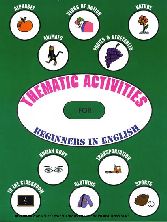Suchen und Finden
Introduction (p. ix-x)
This reproducible book of ten thematically linked units is intended for learners who are just beginning to learn English. The idea behind the book is to ease learners into their new language through the use of illustrations and popular word games and activities. Each unit of THEMATIC ACTIVITIES FOR BEGINNERS introduces twenty-four (twenty-six for The Alphabet unit) arbitrarily chosen vocabulary words on topics commonly taught to beginners. The book is designed to take a student from the introduction of the new vocabulary through a series of graded activities. Each unit starts with a page of numbered SENTENCES.
Each vocabulary word is used in a sentence. The sentences aim to use the words in an everyday context. Teachers are encouraged to use realia, photographs, their acting skills or any other stimuli along with these sentences to introduce the new words. Following is a DRAWINGS page of the vocabulary words depicted pictorially. The drawings are numbered to correspond with the sentences on the previous page.
The drawings are labeled, and below each drawing is a line on which the student can practice writing the vocabulary words being studied. Also, the drawings page can serve as a handy reference tool when completing the other activities. The next page features the same illustrations laid out on the page in a different order. This time the DRAWINGS are labeled, but the letters of each vocabulary word are scrambled.
The student must unscramble the anagrams to write the word. In the next exercise, ORDERING, the student is given a list of the vocabulary words and must put the words in alphabetical order. The QUIZ requires the student to respond to both questions about the vocabulary words in the unit and general knowledge questions about the topic of the unit. In the DASHES exercise the vocabulary words are listed, but there are letters missing from the words. Each missing letter is represented by a dash. The student must complete each word by adding the missing letters. A WORD SPIRAL follows. Each word is on the spiral.
The student must circle the vocabulary words. In the SCRAMBLES exercise, which is a Jumbles type exercise, the illustrations next to each example is a clue to the solution of the puzzle. The answers to the puzzles are taken from the SENTENCES at the beginning of the unit. In the WORD MAZES exercise the illustrations are again used as clues to the solution of the maze. The illustration next to the START of the puzzle depicts the first word of the maze, while the illustration next to the FINISH of the maze depicts the last word required to complete the maze.
In the cloze part of the MAGIC WORD exercise the sentences used are the same as the ones at the beginning of the unit. This provides repetition of the words used in context. Again, the illustration on this page provides a clue to the solution of the puzzle. The EIGHT MISTAKES puzzle, although related to the topic of the unit, requires the student to use more vocabulary than that taught in the unit. If a student has difficulty completing this exercise because of the more complicated vocabulary involved, the student need only number the differences on the drawings.
Alle Preise verstehen sich inklusive der gesetzlichen MwSt.








